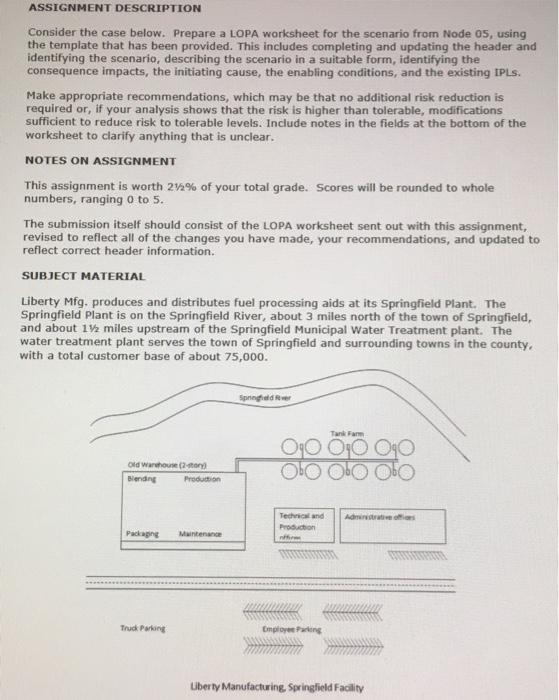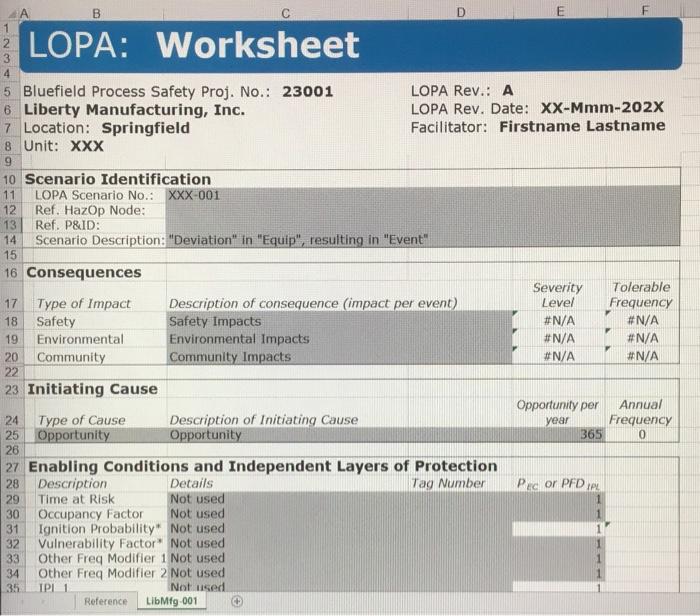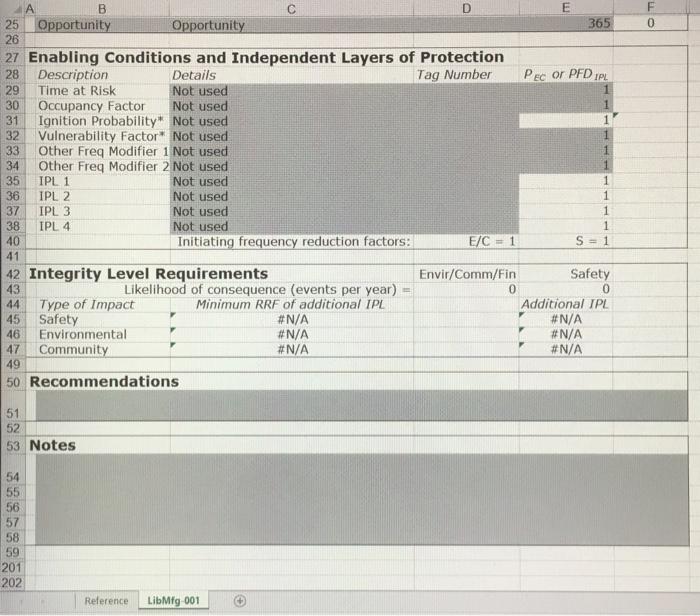Answered step by step
Verified Expert Solution
Question
1 Approved Answer
Please help me figure this out accurately and be as detailed as possible. Thank you in advance. ASSIGNMENT DESCRIPTION Consider the case below. Prepare a
Please help me figure this out accurately and be as detailed as possible. Thank you in advance. 



ASSIGNMENT DESCRIPTION Consider the case below. Prepare a LOPA worksheet for the scenario from Node 05, using the template that has been provided. This includes completing and updating the header and identifying the scenario, describing the scenario in a suitable form, identifying the consequence impacts, the initiating cause, the enabling conditions, and the existing IPLS. Make appropriate recommendations, which may be that no additional risk reduction is required or, if your analysis shows that the risk is higher than tolerable, modifications sufficient to reduce risk to tolerable levels. Include notes in the fields at the bottom of the worksheet to clarify anything that is unclear. NOTES ON ASSIGNMENT This assignment is worth 21/2% of your total grade. Scores will be rounded to whole numbers, ranging 0 to 5 . The submission itself should consist of the LOPA worksheet sent out with this assignment, revised to reflect all of the changes you have made, your recommendations, and updated to reflect correct header information. SUBJECT MATERIAL Liberty Mfg. produces and distributes fuel processing aids at its Springfield Plant. The Springfield Plant is on the Springfield River, about 3 miles north of the town of Springfield, and about 11/2 miles upstream of the Springfield Municipal Water Treatment plant. The water treatment plant serves the town of Springfield and surrounding towns in the county, with a total customer base of about 75,000 . The facility consists of a converted 2-story warehouse building that has warehousing on the ground floor. On the upper floor, there is a production area, a blending area, a packaging area, and the maintenance shop. There is also an administration building, technical/production offices, and an outdoor tank farm for storing raw materials and bulk product. Production operates 24 hours a day, six days a week. Administration, engineering, maintenance, and shipping/receiving personnel are there during normal business hours, five days a week. The site is very crowded; it was originally a warehouse and parking lot, but parking has been moved across the road because the original gravel parking lot was used as the site for the administration building and tank farm. Many of the materials used at the plant are flammable, but none have a flash point less than 100F. There are some acids and bases used at the plant to adjust pH, but not in quantities that exceed the threshold quantity for OSHA PSM or USEPA RMP. Some have health effects-cause rashes, gastrointestinal upset, etc.-but none are acutely toxic (fatal). There is one production process that uses fairly simple chemistry to make a component of some of their products; the process is a mildly exothermic (heat-releasing) reaction that operates at atmospheric pressure and ambient temperatures. That process uses water from the Springfield River for once-through cooling. The remainder of the manufacturing that occurs at the plant consists of blending batches of ingredients, then either filling 55-gallon drums, 275-gallon intermediate bulk containers, or loading tank trucks with the products. Truck loading is at the back of the production building/warehouse, beyond which the property backs up to the Springfield River. The process is mostly manual with very little instrumentation. The reactor is equipped with temperature control, level monitoring, and flow control on the raw materials. The blending and storage tanks have local level gauges that operators check once each 12-hour shift, and before and after transfers into or out of the tanks. A process hazard review of the scenario from Node 05 : * A cooling coil failure in the process, so that process chemicals are released to the river if the cooling water pump is not running. Additional facts about the scenario from Node 05: - The process that uses cooling water has a pump that pulls water from the Springfield River upstream of the plant. - Water is discharged right back to the Springfield River, just downstream of the plant. - The batch procedure calls for turning the pump on at the beginning of the reaction step and turning it off once the reaction is done, but before the batch is drained out. - When the pump is running, the pressure inside the cooling coil is higher than the pressure in the reactor, so a cooling coil leak puts river water into the product. - When the pump is not running, the reactor pressure is higher than the pressure in the coil, so the reactor pressure is enough to force product into the cooling coil, where it can flow by gravity to the river. - The average time for the reaction step is 3.3 hours. The average time from the start of one batch to the start of the next batch is 13.2 hours, but the reactor is empty for 30 minutes of the cycle. - The plant makes about 150 batches of this material a year. ASSIGNMENT DESCRIPTION Consider the case below. Prepare a LOPA worksheet for the scenario from Node 05, using the template that has been provided. This includes completing and updating the header and identifying the scenario, describing the scenario in a suitable form, identifying the consequence impacts, the initiating cause, the enabling conditions, and the existing IPLS. Make appropriate recommendations, which may be that no additional risk reduction is required or, if your analysis shows that the risk is higher than tolerable, modifications sufficient to reduce risk to tolerable levels. Include notes in the fields at the bottom of the worksheet to clarify anything that is unclear. NOTES ON ASSIGNMENT This assignment is worth 21/2% of your total grade. Scores will be rounded to whole numbers, ranging 0 to 5 . The submission itself should consist of the LOPA worksheet sent out with this assignment, revised to reflect all of the changes you have made, your recommendations, and updated to reflect correct header information. SUBJECT MATERIAL Liberty Mfg. produces and distributes fuel processing aids at its Springfield Plant. The Springfield Plant is on the Springfield River, about 3 miles north of the town of Springfield, and about 11/2 miles upstream of the Springfield Municipal Water Treatment plant. The water treatment plant serves the town of Springfield and surrounding towns in the county, with a total customer base of about 75,000 . The facility consists of a converted 2-story warehouse building that has warehousing on the ground floor. On the upper floor, there is a production area, a blending area, a packaging area, and the maintenance shop. There is also an administration building, technical/production offices, and an outdoor tank farm for storing raw materials and bulk product. Production operates 24 hours a day, six days a week. Administration, engineering, maintenance, and shipping/receiving personnel are there during normal business hours, five days a week. The site is very crowded; it was originally a warehouse and parking lot, but parking has been moved across the road because the original gravel parking lot was used as the site for the administration building and tank farm. Many of the materials used at the plant are flammable, but none have a flash point less than 100F. There are some acids and bases used at the plant to adjust pH, but not in quantities that exceed the threshold quantity for OSHA PSM or USEPA RMP. Some have health effects-cause rashes, gastrointestinal upset, etc.-but none are acutely toxic (fatal). There is one production process that uses fairly simple chemistry to make a component of some of their products; the process is a mildly exothermic (heat-releasing) reaction that operates at atmospheric pressure and ambient temperatures. That process uses water from the Springfield River for once-through cooling. The remainder of the manufacturing that occurs at the plant consists of blending batches of ingredients, then either filling 55-gallon drums, 275-gallon intermediate bulk containers, or loading tank trucks with the products. Truck loading is at the back of the production building/warehouse, beyond which the property backs up to the Springfield River. The process is mostly manual with very little instrumentation. The reactor is equipped with temperature control, level monitoring, and flow control on the raw materials. The blending and storage tanks have local level gauges that operators check once each 12-hour shift, and before and after transfers into or out of the tanks. A process hazard review of the scenario from Node 05 : * A cooling coil failure in the process, so that process chemicals are released to the river if the cooling water pump is not running. Additional facts about the scenario from Node 05: - The process that uses cooling water has a pump that pulls water from the Springfield River upstream of the plant. - Water is discharged right back to the Springfield River, just downstream of the plant. - The batch procedure calls for turning the pump on at the beginning of the reaction step and turning it off once the reaction is done, but before the batch is drained out. - When the pump is running, the pressure inside the cooling coil is higher than the pressure in the reactor, so a cooling coil leak puts river water into the product. - When the pump is not running, the reactor pressure is higher than the pressure in the coil, so the reactor pressure is enough to force product into the cooling coil, where it can flow by gravity to the river. - The average time for the reaction step is 3.3 hours. The average time from the start of one batch to the start of the next batch is 13.2 hours, but the reactor is empty for 30 minutes of the cycle. - The plant makes about 150 batches of this material a year 



Step by Step Solution
There are 3 Steps involved in it
Step: 1

Get Instant Access to Expert-Tailored Solutions
See step-by-step solutions with expert insights and AI powered tools for academic success
Step: 2

Step: 3

Ace Your Homework with AI
Get the answers you need in no time with our AI-driven, step-by-step assistance
Get Started


